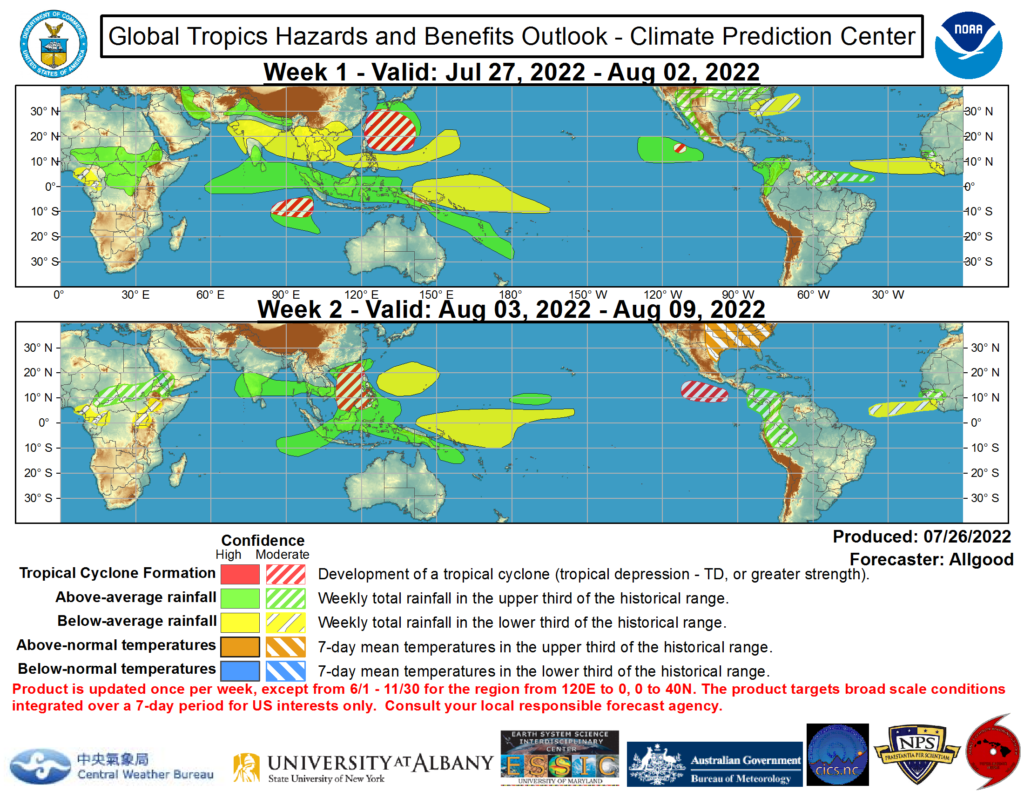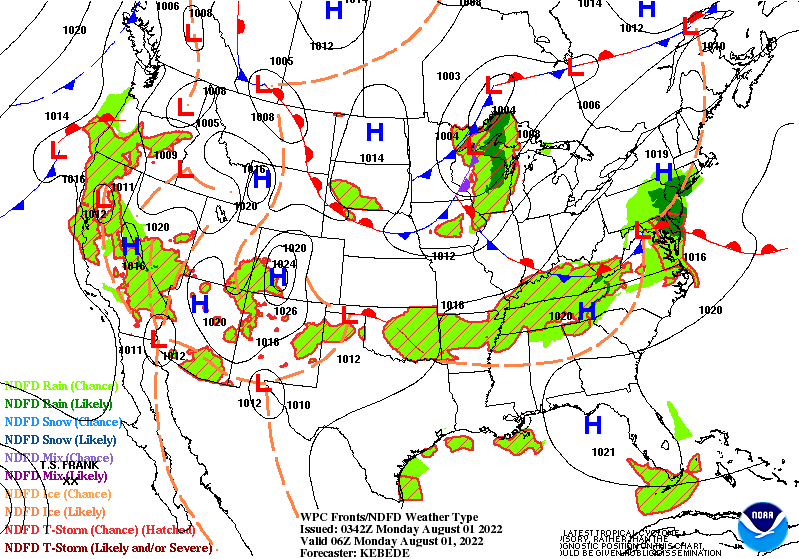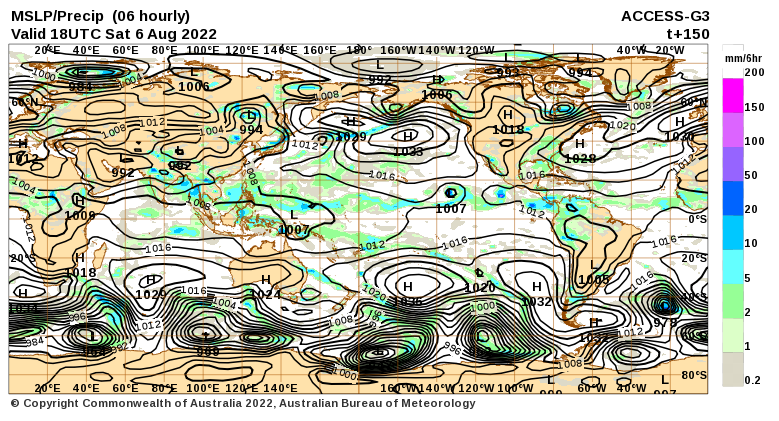Here is what we are paying attention to this evening and the next 48 hours from this evening’s NWS Forecast.
...Heavy rain is likely to continue the flash flood risk over the southern Mid-Atlantic, central/southern Appalachians, and into parts of the Ohio/Tennessee Valley through this evening... ...Anomalous monsoonal moisture over the Southwest to continue the threat of flash flooding over the next few days... ...Some severe thunderstorms will be possible across the Upper Midwest this evening and into the Ohio Valley on Monday, before returning to the Upper Midwest on Tuesday... ...Excessive heat persists over the Pacific Northwest on Monday, while spreading into the northern Plains to start the month of August...
Continuation of the NWS Short Range Forecast (It is updated twice a day and these updates can be found here.
A lingering frontal boundary draped across the Mid-Atlantic and Ohio Valley is finally forecast to begin lifting northward tonight and produce continuing concerns for flash flooding. Parts of southeastern Kentucky are most at risk to flash flooding this evening as soils remain overly saturated from previous drenching rainfall from the past week. Additional storms containing intense rainfall rates are likely to create instances of flash flooding if they pass over this region, prompting a Moderate Risk (level 3/4) of Excessive Rainfall to remain in effect over southeast Kentucky through tonight. Elsewhere, a Slight Risk (level 2/4) of Excessive Rainfall extends along the same boundary from the southern Mid-Atlantic to the lower Mississippi Valley. Here, scattered chances for flash flooding exist. Flooding can be particularly dangerous and hard to see at night, residents are advised to plan ahead before traveling and never drive through a flooded roadway. By Monday, the overall heavy rain threat is expected to diminish as thunderstorm activity becomes more scattered and less organized. However, there remains a concern for additional flash flood chances over susceptible terrain along the central/southern Appalachians and into eastern Kentucky/Tennessee. The other area contending with heavy rainfall chances is over the Southwest and associated with the summer monsoon. Anomalous moisture in place throughout the Southwest and into the central Great Basin will aid thunderstorm development and the potential for numerous downpours. In order to highlight the flash flooding concern, a Slight Risk of Excessive Rainfall is in effect through tonight from southern Nevada and Utah to south-central Arizona and western New Mexico, including parts of southeast California. Areas near recent burn scars, slot canyons, urban corridors, and other vulnerable terrain are most at risk for flooding impacts. The current plume of monsoonal moisture is expected to gradually lift northward on Monday into the Great Basin and eventually spread into the northern Rockies by Tuesday, where isolated flash flooding is possible. Hazardous weather in the form of severe thunderstorms are also possible heading into the beginning of August for some parts of the Nation. An advancing cold front located over the Midwest and central Plains this evening may spark a few strong thunderstorms capable of containing damaging wind gusts, isolated tornadoes, and large hail. Thus, the Storm Prediction Center has issued a Slight Risk (level 2/5) of severe weather over portions of eastern Minnesota and northwestern Wisconsin. Additionally, a few tornadoes and damaging wind gusts cannot be ruled out across North Carolina and southern Virginia tonight as thunderstorms form along a warm front. By Monday, as the aforementioned cold front over the Midwest advances eastward, severe thunderstorms are possible over the Ohio Valley and into parts of the Mid-Mississippi Valley. Damaging wind gusts are expected to be the primary hazard associated with these storms. Fast-forwarding to Tuesday, a separate system entering the northern Plains will potentially produce another round of severe thunderstorms in/around Minnesota. Record-breaking summer heat will remain a major weather story across the Pacific Northwest on Monday, but relief is on the way as the well above normal temperatures shift eastward into the northern Plains by Tuesday. The anomalous upper-level ridge currently located over this Northwest is forecast to be suppressed by strong upper-level energy entering western Canada. This will allow for temperatures over Washington and Oregon to return to near normal by Tuesday. However, highs are still anticipated to reach into the upper 90s and low 100s across the Columbia Basin on Monday, which may threaten daily high temperature records. For the northern Plains, highs 10 to 20 degrees above average are expected over Montana, the western Dakotas, and western Nebraska on Monday, which equates to highs right around 100 degrees. By Tuesday, excessive heat consolidates over South Dakota and surrounding states, where highs are forecast to reach into the triple digits.
Maps that relate the forecast to geography can be found by clicking Here for Day 1 and Here for Day 2.
Here is a 60-hour animated forecast map that shows how the short-term forecast is expected to play out.
If it needs to be updated click here.
HAZARDS OUTLOOKS
Click here for the latest complete Day 3 -7 Hazards forecast which updates only on weekdays. Once a week probably Monday or Tuesday I will update the images. I provided the link for reads to get daily updates on weekdays. Use your own judgment to decide if you need to update these images.
Worldwide Tropical Forecast
(This graphic updates on Tuesdays) If it has not been updated, you can get the update by clicking he re
Detailed Maps and Reports for the Western Atlantic and the Pacific Oceans
Below are three maps that summarize the situation for the Atlantic, Eastern and Central Pacific. Additional information can be accessed by clicking HERE
First the Atlantic
Click to view the forecast map and have access to additional information https://www.nhc.noaa.gov/gtwo.php?basin=atlc&fdays=5
Then Eastern Pacific
Click to view the forecast map and have access to additional information https://www.nhc.noaa.gov/gtwo.php?basin=epac&fdays=5
Then Central Pacific
Click to view the forecast map and have access to additional information https://www.nhc.noaa.gov/gtwo.php?basin=cpac&fdays=5
And the Western Pacific
Click to view the forecast map and have access to additional information https://www.metoc.navy.mil/jtwc/jtwc.html
Some Intermediate-Term Outlooks
Links to “Outlook” maps and discussions for three time periods. Days 6 – 10, Days 8 – 14, and Weeks 3 and 4. An outlook differs from a forecast based on how NOAA uses these terms in that an “outlook” presents information from deviation from normal and the likelihood of these deviations.
You have to click on the links because they do not update automatically and I do not want to have stale images in the article. But it is not difficult to click on a link and you get a large image plus a discussion. On Fridays in a separate article, we will show the images and provide a link in this article that article. But remember what you will see is the images as of Friday. But here you can get the current images simply by clicking on them. Then hit the return arrow at the upper left of your screen to return to the article. You will not find this information easily anywhere else.
Right now you can find these maps here (We show them every Friday there but you can click above and find them).
Forecast for Day 6 (Currently Set for Day 6 but the reader can change that)
World Weather Forecast produced by the Australian Bureau of Meteorology. Unfortunately, I do not know how to extract the control panel and embed it into my report so that you could use the tool within my report. But if you visit it Click Here and you will be able to use the tool to view temperature or many other things for THE WORLD. It can forecast out for a week. Pretty cool. Return to this report by using the “Back Arrow” usually found top left corner of your screen to the left of the URL Box. It may require hitting it a few times depending on how deep you are into the BOM tool. Below are the current worldwide precipitation and air pressure forecasts for six days out. They will not auto-update and right now are current for Day 6. If you want the forecast for a different day Click Here I will try to update this map each day but you have the link so you can access the dashboard and get a wide variety of forecasts.
I mostly rely on the reader to interpret world maps. For this map, areas of expected precipitation for the date and time shown are clearly shown.
The number of High-Pressure systems shown is called the Wave Number. Maybe I will discuss WN someday. But it shows how many Rossby Waves there are around the World. Sometimes they are hard to count. Counting Low-Pressure systems should provide the same WN. Rossby Waves are the way the temperature distribution of the Planet remains in balance. It is basically the science of fluid dynamics. It can be very helpful in predicting the movement of weather patterns.
Month to Date Information
Month to date Temperature can be found at https://hprcc.unl.edu/products/maps/acis/MonthTDeptUS.png
Month to date Precipitation can be found at https://hprcc.unl.e d u/products/maps/acis/MonthPNormUS.png





